Red Robin #26/Batgirl #24 (DC Comics, $2.99)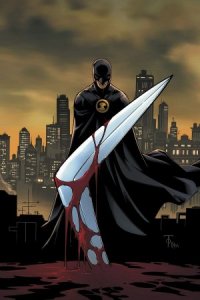
by Graig Kent
We don’t really know what to expect from “the New DC” in September beyond what we’ve been teased, the previews we’ve been shown, and whatever scattershot information writers and artists have revealed in conversation and conventions. We do know Tim Drake is getting an overhaul, remaining “Red Robin” and leader of the Teen Titans, but whether he has any ties to the Batman family is up in the air. Stephanie Brown, though, we’re quite famously aware is no longer going to be Batgirl. as the role is being given back to Barbara Gordon. In fact, we’re not even certain if Stephanie Brown even exists in the New DCU….yet. But that’s the future. We’re only a few weeks away from the beginning, but that means there’s still a few weeks left ’til the end. As such, we say goodbye to Batgirl and Red Robin as series, and perhaps the saddest casualties of the reboot.
Red Robin got off to a rocky start, one that saw Tim Drake, Bruce Wayne’s sidekick and adopted son, forge out on his own in the wake of his mentor’s apparent death, adopting a darker personality and a “lone avenger” type attitude. Tim was forced out of the Robin role when Dick Grayson became Batman and Damian Wayne (Bruce’s natural born son) became his Robin, and while an excellent progression for Damian’s character, kind of a screw job on Tim Drake who had toiled in the role for 20 years, building a solid case that he was the quintessential Robin, not Dick. Tim inexplicably took on the guise of Red Robin, a codename and costume invented for a hypothetical future incarnation of Dick Grayson (in Kingdom Come) and later use “in continuity” by his predecessor Jason Todd…. It all seemed counter-intuitive to the established character behind the mask, and it was a hard adjustment. But first year series writer Christopher Yost built a surprisingly intricate arc for Tim that pitted him against Ra’s Al Ghul and his League of Assassins, proving that Tim was almost as adept at handling the major adversary as Bruce was. In the process, he also rationalized Tim’s shift in character, noting the tragedy in his past, but also showed him overcoming it in a way Bruce never could.
Fabian Nicieza took up the writing chores after Yost and managed to maintain a consistent adventurousness in the tone of the book but added more melodrama to the works, as well as a bigger supporting cast and extrapolating upon Yost’s League of Assassin plot. Nicieza is a veteran comics writer at this point, but seems to always do his best work handling teenage superheroes. His characterization of Tim Drake placed him as an extremely intelligent 17-year-old, but also one that frequently couldn’t escape his own hormones despite his smarts. Nicieza’s final arc finds Tim hunting down a resurrected Captain Boomerang (from Brightest Day) with a pointed mission of killing him in revenge for the murder of his father (back during the Identity Crisis). Anyone who knows the Batman mythos of the past 30 years knows that there’s a strict no-killing policy, and this issue displays Tim’s incredible cunning in setting a trap for Boomerang to meet his own demise, and questions his own morality as he debates whether or not to permit its inevitable conclusion. Nicieza chose not to push the whole “final issue” button by creating some hoary or cheesy ending to summarize Tim’s lengthy career, but instead forging ahead with yet another turning point in Tim Drake’s life. It’s probably for the best as Tim’s lengthy past would be hard to summarize so briefly, but at the same time it also doesn’t provide much in the way of closure.
Red Robin was, for most of its brief existence, an incredibly solid superhero action-adventure book, one that resembled the Batman books of the 1980s, where there was a lot of grit to them but they weren’t so incredibly dark as to not have any relief from the bleakness, and there weren’t any big gimmicks thrown in the mix, just solid storytelling, the building of a rogue’s gallery and of the character. Marcus To and Ray McCarthy have been on the book for the bulk of its run, and they’ve been incredible. To is neither showy nor flashy, but he is dynamic, with impeccably clean lines and exceptional — but not overwhelming — detail. Every few years an artist comes along that I consider the perfect superhero artist, and To joins the ranks of Jose Luis Garcia Lopez and Tom Grummett as one of them. As sad as it is to see Red Robin end, it’s equally sad to see that To doesn’t have a work lined up in “the New 52”.
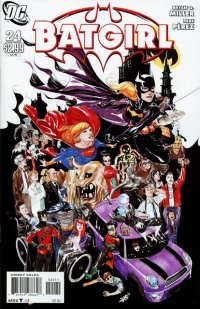 While Red Robin had a tough time out the gate, Stephanie Brown as the new Batgirl was a success from issue one. Under the watchful eye of Smallville writer Bryan Q. Miller, there was absolutely no adjustment period needed, as it was evident Miller had Steph’s voice distinctly resonating in his head, and gave Gail Simone a run for her money as the clear voice of Barbara Gordon as well. What Miller did was take Steph to the Spider-Man school of crime fighting, having her fail as well as succeed, constantly learning, coping with dual identities, and maintaining a strong sense of humour throughout. During the run of the series he acknowledged the character’s past, as well as her legacy, but didn’t dwell on them, instead ever cautious to look forward and prove that Stephanie has earned the mantle.
While Red Robin had a tough time out the gate, Stephanie Brown as the new Batgirl was a success from issue one. Under the watchful eye of Smallville writer Bryan Q. Miller, there was absolutely no adjustment period needed, as it was evident Miller had Steph’s voice distinctly resonating in his head, and gave Gail Simone a run for her money as the clear voice of Barbara Gordon as well. What Miller did was take Steph to the Spider-Man school of crime fighting, having her fail as well as succeed, constantly learning, coping with dual identities, and maintaining a strong sense of humour throughout. During the run of the series he acknowledged the character’s past, as well as her legacy, but didn’t dwell on them, instead ever cautious to look forward and prove that Stephanie has earned the mantle.
This final issue of Batgirl, closing out a thoroughly enjoyable two-year run, finds Miller taking the opposite approach as Nicieza did, wrapping up rapidly what was obviously intended to be a slow-burning storyline, and then offering a glimpse of what he had in mind for the character in the near future, and projecting even further into the future where he would’ve like to see the character eventually wind up. The former part is told in an accelerated fashion, while the latter is told in a series of splash pages, brilliantly executed by Pere Perez, showing just enough detail in each single page to tantalize an entire storyline, and ultimately to add further to the doubtlessly already heavy lament of Stephanie Brown’s fanbase. This was, if not the wholly uncelebrated, at least the thoroughly under-celebrated jewel of DC’s publishing line, and quite possibly the biggest loss as a result of the New 52. Here goes a character, and a writer so in tune with that character, that will likely not be recaptured. It’s unfortunate that DC couldn’t find a way for a gem such as this to carry on(in the same way that Marvel continued to extend the Spider-Girl series despite not sharing continuity with its main lines or even Ultimates line of comics).
But for better or worse (and I’m firmly in the latter on these two) I can see why DC has made the decision they did, and are going in the direction they are going with. Despite coming close, people still identify Dick Grayson as Robin, and I think the only way they will usurp that in the public consciousness is by having Bruce Wayne’s own son be his Robin. In the same way, no matter how good a comic is created with another character under the cowl, Barbara Gordon will be Batgirl, even to those fanboys and girls who prefer her to be Oracle… she’s still THE Batgirl. Tim Drake and Stephanie Brown, and the titles that carry them, are just casualties in a larger scale war with atrophying sales and a slumping industry. But they will be missed.
Red Robin – Rating: 




Out of a Possible 5 Stars
Batgirl -Rating:





Out of a Possible 5 Stars
Baltimore: The Curse Bells #1 (Dark Horse, $3.50)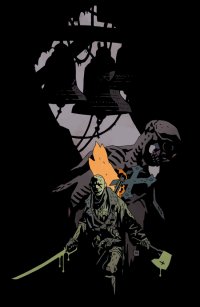
By Adam Prosser
I haven’t read Mike Mignola’s work in a long time, and I hadn’t read the earlier miniseries of his new comic Baltimore at all. It’s a testament to Mignola’s super-clear, elegant storytelling (with an assist from Christopher Golden and artist Ben Stenbeck), though, that there’s nothing at all confusing about this story to a new reader. Mignola knows how to make a story accessible yet gripping; it’s been fascinating to watch Mignola grow from the guy who needed John Byrne’s help with the first Hellboy novel to the confident storyteller he is today.
The story is set in an alternate version of Europe, in which World War I was seemingly cut short by a plague that raised the dead and unleashed an army of vampires—but also awoke older, more evil things that had been asleep until man’s war stirred them up. Lord Henry Baltimore had an encounter on the battlefield with an old vampire named Haigus, who subsequently killed his whole family. Now Baltimore does the “grim wandering monster-slayer” thing while seeking for Haigus, like an early 20th century Jim Dresden (hey, is it a rule now that monster-killers have to have a city in their names?)
In this particular volume, Baltimore nearly falls prey to a trap involving both vampires and demons, and then stumbles across a town with a convent full of undead nuns, and one chatty would-be vampire expert and exposition machine. As with much of Mignola’s work, the story here is very action-oriented, and despite the surprisingly complex mythology and the elaborate dialogue of the later pages, the emphasis is squarely on the action sequences, which sprawl across several pages. Nobody handles action sequences like Mignola, and it’s always entertaining to me that, even when someone else is handling the art, you can always recognize his storytelling style. That’s partly because Stenbeck, like many of Mignola’s collaborators, imitates his artistic style to a certain degree (though Stenbeck lends a more “mainstream” feel to the art than most of Mignola’s projects), but it’s also the very distinctive series of mood-setting establishing panels and mix of long shots and close-ups on haunting details or ominous shots of monsters peeking out from the shadows or reveals that someone’s been bitten by a vampire. And, of course, the lovingly rendered old European architecture—Mignola loves his architecture.
Story-wise, of course, this isn’t a vast remove from the usual Hellboy stuff—monster killer kills monsters against gothic old-world backdrop. Mignola’s a guy who knows what he does well, and is happy to keep working in that mode. It seems his fans are happy to see him doing this as well, so if you’re one, you know what to expect. And why should that be a problem, when he does it so well?
Rating: 




Out of a Possible 5 Stars
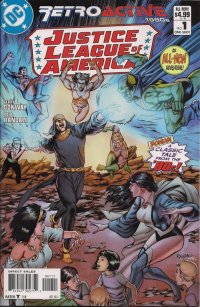 DC Retroactive 1980’s Justice League of America one-shot/DC Retroactive 1980’s Superman one-shot (DC Comics, $4.99)
DC Retroactive 1980’s Justice League of America one-shot/DC Retroactive 1980’s Superman one-shot (DC Comics, $4.99)
by Graig Kent
This is the fourth week of the DC Retroactive series, and although I had a lot of initial anticipation and excitement, in some respects the overall project is a bit of a let down. I’ve mentioned in previous weeks how the presentation and coordination of the books could be improved, and also how the match-ups between writers and artists have been lacking authenticity.
That latter point is readily apparent in the Justice League and Superman Retroactive books this week. While the writers, Gerry Conway and Marv Wolfman, respectively, are obviously the right choices for the job, they’re paired with artists who aren’t exactly representative of the time. Though Ron Randall was working in the mid-1980’s his work on the Justice League didn’t appear until Justice League International in the early 1990’s, while Sergio Cariello is equally better known for his work in multiple venues in the ’90’s, but with no real association with Superman. In both cases, viewing the artwork of the “Retro” story next to the reprinted back-up feature, the distinct differences in style, storytelling language, and, especially, coloring is probably the most jarring aspect of the Retroactive line. Despite this, the coloring and Randall’s linework in the Justice League book is quite attractive, however Cariello’s work on the Superman book looks rushed and sloppy with muddy coloring.
The Retroactive 1980’s Justice League of America resurrects the “Detroit League” as it’s come to be known. More than any other League before, and arguably since, this one was bogged with second stringers. As if that weren’t readily apparent enough, Conway’s story hammers home the point repeatedly as the team bickers and argues amongst each other whilst trying to save their headquarters and a group of touring schoolchildren from an attack by Felix Faust. It’s an exceptionally hammy story in which one of the school children (tellingly named Geoff, I assume as a nod to Geoff Johns) essentially saves the day by giving the team a pep-talk. But as hammy as it is, it’s proper to the storytelling of the Detroit League as witnessed by the thoroughly uncharming back-up, reprinting Justice League of America #239. In this back-up, Aquaman has to defend his League of losers to the big guns (with a thoroughly unconvincing argument, I might add, but it gives readers unfamiliar with the League of the era insight into its origins), while Vixen jets off to handle personal business, which takes up the bulk of the book. It’s truly not a shining example of the appeal of the Detroit League, but I’m not certain there is a shining example of the Detroit League. It’s the most maligned incarnation of the Justice League for a reason.
The Retroactive 1980’s Superman story is equally unappealing reading. Like the Retroactive 1970’s Superman 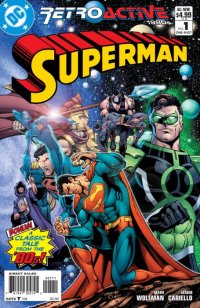 book, this one features a very tired Superman requiring some sleep. Unfortunately Destiny (of the Endless) comes knocking and presents Superman with a glimpse into his future (with Wolfman presenting in quick snippets some major events throughout the DCU from the past 30 years), but also a choice, which bears a passing resemblance to Galactus’ offer to Norrin Radd. In concept it should have been interesting, or at least entertaining to start thrusting post-Crisis references upon a pre-Crisis Superman, but the entire exercise is weightless, as we all know the content of Superman’s character and the decision he’s going to make is obvious from the beginning (and he states it just the same).
book, this one features a very tired Superman requiring some sleep. Unfortunately Destiny (of the Endless) comes knocking and presents Superman with a glimpse into his future (with Wolfman presenting in quick snippets some major events throughout the DCU from the past 30 years), but also a choice, which bears a passing resemblance to Galactus’ offer to Norrin Radd. In concept it should have been interesting, or at least entertaining to start thrusting post-Crisis references upon a pre-Crisis Superman, but the entire exercise is weightless, as we all know the content of Superman’s character and the decision he’s going to make is obvious from the beginning (and he states it just the same).
The back-up feature is well coordinated with the main feature (for a change), presenting Superman’s first encounter with Destiny from Superman #352, written by Wolfman, with art by Curt Swan. It’s a perfect example of Wolfman’s often overwrought scripts, compete with hammy social commentary (One black man says to the other, “Hmphh! Never thought he’d come to this part o’ town!” To which the other replies, “Man, he’s one of the few dudes anywhere who’s 100 percent colorblind!”). Here Superman is forced by Destiny to retire as his intervening on the citizens of Metropolis is making them unable to take care of themselves. It’s a lesson learned by way of an orphanage being threatened by cartoonish land barons and the day is saved by Lois and a pastor.
What these two books do is shine a light on just how awkward the transition was for DC Comics as they tried to mature in the 1980’s. The results of the groundwork they laid is still reflected today, but man, there were a lot of growing pains getting there.
Both: Rating: 




Out of a Possible 5 Stars
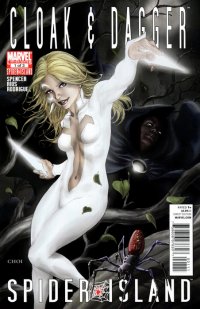 SPIDER-ISLAND: CLOAK & DAGGER #1 OF 3 (Marvel, $2.99)
SPIDER-ISLAND: CLOAK & DAGGER #1 OF 3 (Marvel, $2.99)
By Jeb D.
Now, this is how you do a spinoff miniseries: take some characters with a strong cult following, but no track record for catching fire with the general comics reading public; find a storyline that can intersect with, but not be restricted by, the current ongoing event; enlist a writer with a deft hand at blending characterization with story movement; hand it over to an artist with a unique vision; and presto! What could be easier, right…?
Writer Nick Spencer is the latest indie guy helping to shape the Marvel Universe into a place that can balance the commercial realities of today’s comic market with top-notch storytelling. I don’t know what level of knowledge/affection he might have had for Cloak and Dagger going into this project, but his work on Morning Glories certainly makes these quirky characters seem tailor-made for him. The plotting is simple and nicely structured: Ty (Cloak) and Tandy (Dagger) are trying to get themselves established in New York when the “Spider-Island” spider infection breaks out, and they find themselves swept up into an attempt by one of the Avengers teams to quell the outbreak, all the while trying to sort out the day to day details of assuming responsibility for their “great power” in a modern urban setting; meanwhile, alternating internal monologues lay out their convoluted backstory and complicated relationship. Elsewhere, the villain of the piece makes his entrance, and the dialog exchange he has with an ancient fortuneteller is not only ominous for Cloak and (especially) Dagger, but sharp and funny in a way that feels completely natural while staying true to the tropes of comic book villainy. The book is full of little light touches and grace notes that I won’t spoil, but that will leave the reader smiling anew every couple of pages.
Artist Emma Rios beautifully captures the story’s inherent contrasts, between the urban darkness of Cloak’s power (and background), and the luminal, ethereal qualities of Dagger (colorist Javier Rodriguez also deserves props for aiding in the effectiveness of that contrast), with fine facial distinctions and some nicely filled-out backgrounds. Her action sequences are more capable than exceptional, and the panels sometimes feel more crammed than populated, but here and there, her vision of the intersection of the mystic and the mundane puts me in mind of classic Ditko.
Editor Steve Wacker sums things up at the end of the book by making it clear that Marvel would love to see this miniseries as a launching point for a full-blown Cloak and Dagger ongoing. If they can keep this creative team together, I’d be completely onboard for that.
Rating: 




Out of a Possible 5 Stars